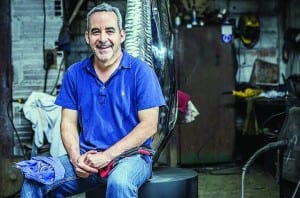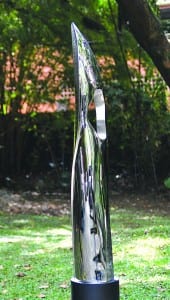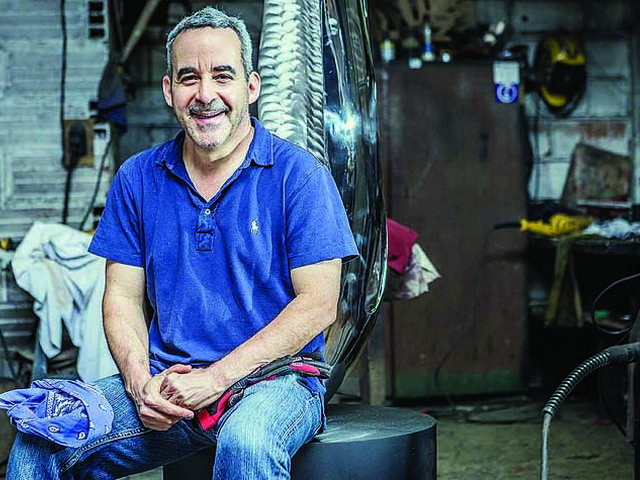
Santiago Medina has walked dual paths of medicine and art as he pursued a need to help humanity and a passion for creativity. He found a way to combine both entities to deliver beauty and compassion.
Medina, 51, hails from Medellin, Colombia and came to the United States in 1990 to continue his studies in medicine. But that came after a childhood devoted to studying art.
“I grew up in Colombia and went through a rigorous training at an art academy from when I was five years old until I was 22,” he says.
“When I was growing up, there was a lot of art in my house and in the family. My great grandfather was a professional artist and photographer, and my grandfather also was an artist.”
 After devoting his youth to studying be a painter, when he turned 18 years old he was faced with a crossroads of life and the need to make a decision. But he was uncertain about the professional path to take — to be an artist or go into medicine.
After devoting his youth to studying be a painter, when he turned 18 years old he was faced with a crossroads of life and the need to make a decision. But he was uncertain about the professional path to take — to be an artist or go into medicine.
“So I went into medicine, but I kept working on my art,” he says. “Medicine migrated into the area of brain imaging and body imaging, which is related to sculpture and painting, I think. Over the years, I have been able to merge both sides.”
When he was 26, Medina was accepted to Washington University in St. Louis to work in the 3D imaging field, a promising area of medicine that was at its early stage. He had researched medical imaging and early on recognized the potential and benefit of the new field. He trained at Washington University for four years before moving to Boston to hone his medical imaging knowledge with the Harvard Medical System, where he made a monumental decision to specialize in advanced brain imaging in children.
He spent three years there and worked at Boston Children’s Hospital and Massachusetts General, two of the flagships of the Harvard System. He was offered a position in medical imaging at the Cincinnati Children’s Hospital Medical Center and the University of Cincinnati where he worked for three years. At the same time, he continued to pursue his passion for art and studied at the Cincinnati Institute of Art, focusing on sculpture.
 Medina’s reputation, expertise and knowledge of medical imaging soon attracted the interest of the Miami Children’s Hospital. He accepted an offer and moved to Miami in 1999 with his wife, Olga, where they bought a home in the blossoming community of Pinecrest and raised two daughters, Camila, 22, and Isabela, 17.
Medina’s reputation, expertise and knowledge of medical imaging soon attracted the interest of the Miami Children’s Hospital. He accepted an offer and moved to Miami in 1999 with his wife, Olga, where they bought a home in the blossoming community of Pinecrest and raised two daughters, Camila, 22, and Isabela, 17.
“I had many friends in Miami who were artists,” Medina says. “They told me that Miami was changing dramatically and going into this new era of art. So, I came and I liked the city; it was very open and I was closer to home, so we moved here and it has been great!”
Today, Medina is a doctor and co-director of the neuroradiology (brain imaging) division at Miami Children’s Hospital, working with neurosurgeons as they prepare to operate on a patient and remove a brain tumor.
“We have to give the surgeons 3D images that show the exact location of the tumor, and the artistic side does kick in because imaging is like a sculpture of the human brain in multiple colors.”
Medina says his art career accelerated after the move to Miami. He already knew many of the players in the Miami art world and he became involved with the art community and several ateliers.
“Basically, my art just took off,” he says. “The whole city just grew up at a very fast rate.”
 Medina today is recognized as a Master Sculptor and his stainless steel sculptures are on permanent display at public art venues such as Harvard, Stanford, Tufts and Washington University, among many others. He is the only Colombian-American sculptor to have a permanent monumental sculpture at Harvard University. His pieces have been displayed at major art fairs such as Art Basel Miami, Houston Art Fair, Palm Beach International Art Fair and Arte America. He attributes much of his success in art to his ability to combine his medical imaging knowledge with his sculpture and he concedes that body imaging computer technology is helpful in the creation process.
Medina today is recognized as a Master Sculptor and his stainless steel sculptures are on permanent display at public art venues such as Harvard, Stanford, Tufts and Washington University, among many others. He is the only Colombian-American sculptor to have a permanent monumental sculpture at Harvard University. His pieces have been displayed at major art fairs such as Art Basel Miami, Houston Art Fair, Palm Beach International Art Fair and Arte America. He attributes much of his success in art to his ability to combine his medical imaging knowledge with his sculpture and he concedes that body imaging computer technology is helpful in the creation process.
“The software we use in medicine is extremely sophisticated and I use it in my art,” he says. “There is a constant cross fertilization between medicine and art and that is what has pushed my career for the last 15 years, bringing the two together. Imaging is radiology and uses high-end sophisticated equipment such as Computerized Tomography (CT) scans and Magnetic Resonance Imaging (MRI) which generate 3D images of the human body. Then I use that software to generate sculpture, scanning my sculptures and modifying them.”
With his international success in the art world, Medina says people often ask him why he continues to work in the medical field.

“I don’t work as much as I did in the past,” he says. “But I still do it for two reasons. First, I can stay in touch with the high and sophisticated software. It is very unique, advanced equipment that I can use for my art work, especially in my specialty now, sculpture. And the second thing is that I stay in touch with the human side of suffering — disease, happiness, sadness, the turmoil — that I see daily in the hospital. For me it’s an extremely powerful source of inspiration.
“Medicine is a part of my life that has been very important, but I think at the core of what I have done all of my life is art.”
For more information, go to www.MedinaFineArt.com.






